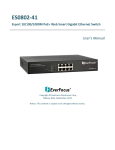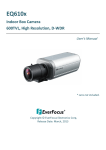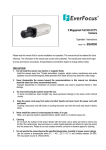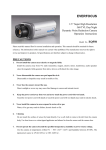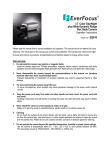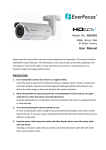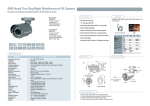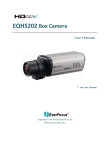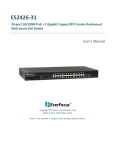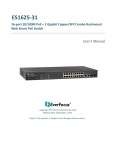Download EverFocus EQ610s User`s manual
Transcript
EQ610s Indoor Box Camera 700TVL, True Day/Night, Super Low-Light, D-WDR User’s Manual V2.1 * Lens not included. Copyright © EverFocus Electronics Corp, Release Date: January, 2013 CAUTIONS 1. Do not install the camera near electric or magnetic fields. 2. Never disassemble the camera beyond the recommendations in this manual nor introduce materials other than those recommended herein. 3. Try to avoid facing the camera toward the sun. 4. Keep the power cable away from water and other liquids and never touch the power cord with wet hands. 5. Never install the camera in areas exposed to oil, gas or solvents. 6. Do not operate the camera beyond the specified temperature or humidity. Use the camera at temperatures within -10°C~50°C (14°F~122°F) and humidity between 20%~ 80%; this device is not rated as submersible. 7. The input power source is 12 VDC / 24 VAC~ or 90-260 VAC~. i EQ610s 1. INTRODUCTION The EverFocus Polestar III-series EQ610s box camera features an incredible 700TVL resolution in full color with a low-light sensitivity of 0.03 lux. Delivered by Sony EXview HAD CCD II 960H sensor, the camera also features the added benefits of advanced Effio-S DSP technology to enhance image quality. This camera also utilizes technologies like 3DNR (to reduce recording file sizes and thus conserve DVR HDD space), Digital Slow Shutter (to display images in very low-light by enabling super high-light sensitivity of up to 0.00006 lux), Digital Wide Dynamic Range, Day/Night mode switching, Digital Image Stabilizer, Privacy Masking, Motion Detection, 256x Digital Zoom, Mirroring, and etc. 1.1 FEATURES • 700TVL image quality with Sony 1/3” EXview HAD CCD II 960H sensor • Starlight super-high sensitivity of 0.00006Lux/F=1.2 is achieved by Digital Slow Shutter (Sens-Up 512x) • The Sony Effio-S platform performs advanced camera functions and delivers excellent picture quality • True Day/Night function with ICR module • Supports 3D & 2D Noise Reduction • High sensitivity, low smear, high anti-blooming and high S/N ratio for high-performance video • Easy-to-use OSD setup menu • D-WDR functions enabled by Sony Extended ATR technology • Supports Back Light Compensation (BLC), High Light Compensation (HLC), Auto Electronic Shutter (AES), Auto Gain Control (AGC), Auto White Balance (AWB), Digital Image Stabilization, Digital Zoom, Motion Detection and Privacy Mask functions • Provide control interfaces: RS-485, D/N In, D/N Out and Motion Alarm Out 1.2 PACKAGE CONTENTS • 1 x Camera Unit • 1 x User’s Manual • 1 x Accessory Pack with Screws • 1 x Mounting Bracket • 1 x C-mount Adaptor • 1 x Power Cable Pigtail (only for 12 VDC / 24 VAC~ model) 1 EQ610s 1.3 SPECIFICATIONS Pickup Device Video Format Picture Elements (H x V) Horizontal Resolution Sensitivity S/N Ratio Video Output Gamma Correction Lens Type High Light Auto Electronic Shutter Auto Gain Control Auto White Balance Sync. Mode Day & Night Mode OSD Menu DNR D-WDR (Extended ATR) Digital Slow Shutter Digital Image Digital Zoom RS-485 Control Digital I/O Control Mirror Motion Detection Privacy Mask Power Source Power Consumption Operating Temperature Dimensions (W x D x H) Weight 1/3" Sony 960H EXview HAD CCD II NTSC PAL 1020 x 508 1020 x 596 700TVL 0.03 Lux / F1.2; 0.00006 Lux / Sens-up 512x Over 52dB (AGC off) 1.0Vp-p Composite, 75Ω ; BNC 0.45 C/CS Mount (Lens sold separately) ON / OFF / AUTO 1/60(50) ~ 1/100,000 sec. 0~200 Levels adjustable ATW / AWB / 3200K / 6300K / ANTI CR / PUSH LOCK / MANUAL Internal External / Auto / DN IN / Color / B&W OSD Control (English / Simplified Chinese / Traditional Chinese) 3DNR: OFF / ON / MIDLOW / MID / MIDHIGH / HIGH OFF / BLC / WDR Sens-Up ~512x Yes Yes Yes D/N In ; D/N Out ; Motion Alarm Out Normal / Vertical / Mirror / Rotate On / Off for 24 x16 Detection Zone Blocks On / Off for 8 Zones Programmable, Mosaic Two types: 90-260 VAC~ or 12 VDC / 24 VAC~ 12 VDC / 24 VAC~: 2.4W max. 90-260 VAC~: 4W max . -10˚C~50˚C / 14˚F~122˚F (20%~ 80% humidity) 68x56x120mm / 2.6”x2.2”x4.7” 300g / 0.66lbs 2 EQ610s 2. CAMERA OVERVIEW 2.1 NAMES AND FUNCTIONS OF PARTS 2.1.1 FRONT PANEL Light Sensor Microphone (Reserved for Audio-supporting models) 2.1.2 BRACKET POSITIONS The bracket in the package can be fitted to the screw holes on the top or bottom of the camera for either suspending the camera or supporting it. Top bracket position Bottom bracket position 3 EQ610s 2.1.3 BACK PANEL 2 1 1 3 2 3 4 5 4 5 GND D/N Out D/N In Motion RS485RS485+ GND D/N Out D/N In Motion RS485RS485+ 8 6 7 7 AC 24V / DC 12V 6 LINE IN 8 + - 12 VDC / 24 VAC~ Model 90-260 VAC~ Model Side Panel: 9 1) Terminal Block -GND: Ground pin -D/N Out (Day/Night control output): When the camera is in Day mode, it will send out a low-level signal of 0V to the external device. When the camera is in Night mode, it will send out a high-level signal of 3.3V to the external device. -D/N In (Day/Night control input): Please set the D/N limit switch to OFF, so that the camera can receive an external Day/Night signal (for example, from a device on the housing) and synchronize the external device’s Day/Night mode with that of the camera. -Motion: Alarm output for in case motion is detected. If the alarm output is connected and a motion is detected, the message “MOTION DETECTED” will appear on the screen and the camera will also send out a high-level signal of 3.3V to the alarm output. As long as no motion is detected, a default low-level signal of 0V will be maintained to the alarm output. -RS485-/RS485+: Connect to an RS485 cable for keyboard control. 2) Left-scroll button 3) Up-scroll button 4) Set button (push to activate OSD) 5) Right-scroll button 4 EQ610s 6) Down-scroll button 7) Video Output Connector BNC connector that connects to a 75 Ohm coaxial cable to feed the video output of the camera to a color monitor or other video devices. 8) Power Input Terminal Connects to the appropriate power source (12 VDC / 24 VAC~ or 90-260 VAC~). 9) Auto Iris Lens Connector This connector is used to connect to an auto iris lens via a 4-pin male connector. Pin1 Pin2 Pin3 Pin4 Direct Drive CntCnt+ Drv+ Drv- 3 INSTALLATION 1. Unscrew the protection cap from the mouth of the lens mounting. 2. If a C-mount lens is to be used, please screw the C-mount adaptor ring (the 5mm-thick ring in the accessory pack) on to the mouth of the lens mounting. 3. Mount the lens by turning it clockwise on the lens mounting of the camera. 4. If you use an Auto Iris lens, connect the lens’s cable to the Auto Iris lens connector on the side of the camera. 5. Place an ND filter in front of the lens, adjust the lens focus until the best image is obtained. 6. Lock the lens’s focus position by tightening the swivel screw, and then remove the ND filter. Mount the lens 5 EQ610s 4. CONNECTIONS 1. Connect the cable from the keyboard’s RS485 port to the camera’s two corresponding RS485 terminal block connectors. 2. Connect the cable from the video output jack of the camera to a monitor’s input jack. 3. The RS485 ID has to be the same as the CAM ID of the keyboard. (Please refer to the “6.9 System” section.) 4. The Baud rate has to be the same as the keyboard’s Baud rate. (Please refer to the “6.9 System” section.) 6 EQ610s 5. CAMERA SETUP OPERATIONS This camera utilizes an On Screen Display (OSD) user setup menu. 5.1 SETUP BUTTONS To set items on the user setup menu, use the following buttons on the back panel. Set (Enter) button The cursor direction buttons and the SET/Enter button ① ENTER Press this button (by pressing straight down on the stick) to display the OSD’s main menu on the monitor that you have connected directly or indirectly to the camera’s video connector. Also press this button to confirm changes and to open the submenus when they’re available and selected. (Menu items with a “<┘” symbol at the end contain submenus. For adjusting submenu items, select the desired menu item with the and buttons and press the ENTER button to open the desired submenu. Use the and buttons to toggle between value options.) ② R (RIGHT) Press this button (by pressing the control stick to the right) to move the on-screen cursor to the right to select items or to adjust the level/intensity of a selected function. The level/intensity increases when this button is pressed. ③ L (LEFT) Press this button (by pressing the control stick to the left) to move the cursor to the left to select items or to adjust the level/intensity of a selected function. The level/intensity decreases when this button is pressed. ④ D (DOWN) Press this button (by pressing the control stick in the “down” direction) to scroll the on-screen cursor downwards between menu items. ⑤ U (UP) Press this button (by pressing the control stick in the “up” direction) to scroll the on-screen cursor upwards between menu items. 7 EQ610s 5.2 OSD Operation ** MAIN MENU ** LENS EXPOSURE WDR WHITE BALANCE 2DNR & 3DNR DAY/NIGHT IMAGE EFFECT SYSTEM EXIT<┘ AUTO<┘ SET<┘ OFF ATW <┘ SET<┘ AUTO<┘ SET<┘ SET<┘ SET<┘ 1. Open the OSD menu Press the ENTER button to open the OSD’s main menu on your screen. 2. Scroll with the cursor buttons to select menu items Use the and buttons to move the cursor up and down to scroll to the desired menu items. 3. Toggle between the right-hand options (modes) of each menu item Use the and buttons to change the modes of menu items and to access the submenus of those modes (to adjust the parameters or values of submenu items – where applicable). Menu items with a “<┘” symbol at the end contain submenus. (If the right-hand menu title is “SET”, it means that there are no modes to choose from, only a settings submenu for the left-hand main menu item.) 4. Open submenus Right-hand items (or “modes”) with a “<┘” symbol at the end contain submenus. For adjusting submenu items, select the desired menu item with the and buttons, then select the desired submenu title (or “mode”) to the right of the menu item with the and buttons, then press ENTER to open the submenu. 5. Return to the previous page Scroll to RETURN and press the ENTER button to return to the previous page. 6. Exit the OSD menu Scroll to EXIT and press the ENTER button to exit the OSD menu. 8 EQ610s 6. Configuration with the OSD 6.1 LENS Once you have opened the OSD’s main menu on your screen, use the UP and DOWN buttons to scroll to the “LENS” menu item. Use the LEFT and RIGHT buttons to toggle between the MANUAL and AUTO modes. If you selected AUTO, you can press the ENTER button to open the LENS > AUTO submenu (also called “Auto Iris”). ** MAIN MENU ** ** AUTO IRIS ** AUTO<┘ SET<┘ OFF ATW <┘ SET<┘ AUTO<┘ SET<┘ SET<┘ SET<┘ LENS EXPOSURE WDR WHITE BALANCE 2DNR & 3DNR DAY/NIGHT IMAGE EFFECT SYSTEM EXIT<┘ |||||||||||||||| 050 SPEED RETURN<┘ Submenu Main Menu SPEED The speed of the DC Iris lens depends on the number you set here. The range of SPEED setting options is 000 to 255. The higher the number, the faster the responses of the Iris lens. Push the LEFT and RIGHT buttons to decrease or increase the number. 6.2 EXPOSURE Once you have opened the OSD’s main menu on your screen, use the UP and DOWN buttons to scroll to the “EXPOSURE” menu item. Press the ENTER button to open the Exposure submenu. ** MAIN MENU ** LENS EXPOSURE WDR WHITE BALANCE 2DNR & 3DNR DAY/NIGHT IMAGE EFFECT SYSTEM EXIT<┘ ** EXPOSURE ** AUTO<┘ SET<┘ OFF ATW <┘ SET<┘ AUTO<┘ SET<┘ SET<┘ SET<┘ MODE BRIGHTNESS SHUT SHUT MAX LOW LUX BRIGHT. AGC GAIN SENSE UP RETURN<┘ Main Menu Submenu 9 AUTO IRIS |||||||||||||||| 030 1/50 (S) x1.0 |||||||||||||||| 150 OFF EQ610s MODE There are two modes to select from: AUTO IRIS and SHUT+AUTO IRIS. To change the mode, highlight the MODE field and press the LEFT and RIGHT buttons to toggle between the two modes. In AUTO IRIS mode, SHUT (shutter speed) is activated and adjustable while SENSE UP and SHUT MAX are deactivated. In SHUT+AUTO IRIS mode, SHUT MAX and SENSE UP are activated and adjustable. The SHUT MAX value that you select will be the maximum shutter speed that will be allowed in automatic mode. BRIGHTNESS Scroll to the BRIGHTNESS field and use the LEFT and RIGHT buttons to adjust the screen brightness (000 to 255). SHUT (shutter speed) / SHUT MAX (maximum allowed shutter speed for auto) Use the LEFT and RIGHT buttons to adjust the shutter speed (or to select the maximum shutter speed – SHUT MAX – for when the camera is in SHUT+AUTO IRIS mode). The shutter speed and maximum shutter speed can be set to be anything from a 50th of a second up to a 100,000th of a second. LOW LUX BRIGHT. (Low Lux Brightness) Use the LEFT and RIGHT buttons to adjust the Low Lux Brightness value. The options are x0.25, x0.5, x0.75, x1.0. AGC GAIN (Automatic Gain Control) The bigger the number, the brighter the image. Note that the noise will also increase as the AGC GAIN is increased. The selectable AGC GAIN values are 000 to 200. SENSE UP SENSE UP is used to maintain a vivid screen image by automatically detecting changes in light levels when the light levels are generally low. Use the LEFT and RIGHT buttons to switch this function on/off and adjust its settings. The options are OFF, x2, x4, x8, x16, x32, x64, x128, x256, x512, and OFF. 10 EQ610s 6.3 WDR 1. When the main menu is displayed on the screen, use the UP and DOWN buttons to scroll to the “WDR” menu item. ** MAIN MENU ** AUTO<┘ SET<┘ OFF ATW <┘ SET<┘ AUTO<┘ SET<┘ SET<┘ SET<┘ LENS EXPOSURE WDR WHITE BALANCE 2DNR & 3DNR DAY/NIGHT IMAGE EFFECT SYSTEM EXIT<┘ The WDR modes are WDR, BLC, and OFF. 2. Press the LEFT and RIGHT buttons to switch this function OFF or to put it in BLC mode or WDR mode. Press ENTER to enter the submenu of the selected mode. WDR (Wide Dynamic Range) When the camera is pointed at a scene that has both bright and dark areas, selecting this mode evens out the contrast and makes these contrasting areas distinctive. ** WDR ** LEVEL DARK AREA BRIGHT AREA |||||||||||||||| 185 MIDHIGH |||||||||||||||| 000 RETURN<┘ Submenu of the WDR function. - LEVEL Use LEVEL to adjust the brightness of the whole area (000~255). - DARK Use DARK to only adjust the brightness of the dark areas (LOW to HIGH). - BRIGHT Use BRIGHT to only adjust the brightness of the bright areas (000~255). 11 EQ610s BLC (Back Light Compensation) On the main menu, scroll to WDR and select BLC mode in the right-hand column. Even when there is a bright backlight behind an object, bright images of the object and its background can still be captured by selecting the BLC mode. ** BLC ** MODE AREA MANUAL LEVEL AUTO LEVEL AUTO --|||||||||||||||| 008 The BLC modes are AUTO and MANUAL. RETURN<┘ Submenu of the WDR > BLC mode. - AUTO Select AUTO to adjust the BLC automatically. The range is 000~015. - MANUAL Selecting MANUAL lets you select the AREA and MANUAL LEVEL, to adjust the BLC value manually. The default AREA value is BOTTOM 1/3, and the default MANUAL LEVEL value is MID. With these default values, the bottom third of the screen will be the brighter area, using the middle level of brightness. AREA: BOTTOM 1/3, TOP 2/3, BOTTOM 2/3, LEFT 2/3, and RIGHT 2/3. MANUAL LEVEL: HIGH, MID, and LOW. 6.4 WHITE BALANCE The screen color can be adjusted by using the WHITE BALANCE function. 1. Scroll to WHITE BALANCE on the main menu and use the LEFT and RIGHT buttons to toggle between this menu item’s seven mode options. 2. Select the desired mode and press ENTER to open the mode’s adjustment submenu. ** MAIN MENU ** LENS EXPOSURE WDR WHITE BALANCE 2DNR & 3DNR DAY/NIGHT IMAGE EFFECT SYSTEM EXIT<┘ AUTO<┘ SET<┘ OFF ATW <┘ SET<┘ AUTO<┘ SET<┘ SET<┘ SET<┘ The modes for WHITE BALANCE are ATW, AWB, 3200K, 6300K, ANTI CR, MANUAL, and PUSH LOCK. 12 EQ610s ATW (Auto Trace White Balance) This mode can be used to view areas with a color temperature range of 1800°K to 10500°K (e.g., around fluorescent lights, outdoors, around sodium vapor lamps or inside tunnels). Press ENTER if you want to access the ATW setting options. AWB (Auto White Balance) Select this to allow the camera to automatically adjust the white balance under all conditions. 3200K Select this mode when the color temperature is around 3200°K (when surrounded by sodium lights). Press ENTER if you want to access the setting options. 6300K Select this mode when the color temperature is around 6300°K. Press ENTER if you want to access the setting options. ANTI CR (Color rolling suppression) Select ANTI Color Rolling mode to suppress color rolling incidents. Follow the instructions on the screen. Note: The WHITE BALANCE can not function effectively under the following conditions. When the following occurs, please select PUSH LOCK Mode. < When the color temperature in the surveillance area is high. < When darkness surrounds a surveillance area. < When there’s a fluorescent light in the surveillance area or the light changes all the time. MANUAL This mode enables more precise adjustments. Increase and/or decrease the Red Gain and Blue Gain values to suit the light in the surveillance area. PUSH LOCK For this mode, follow the instructions given on your screen. To find this mode’s optimal setting for the surveillance area’s luminance environment, point the camera towards a sheet of white paper before entering the PUSH LOCK adjustment sequence. Press the ENTER button while pointing the camera at the sheet. Ideally, this adjustment sequence should be repeated whenever the luminance environment changes. 13 EQ610s 6.5 2DNR & 3DNR (Digital Noise Reduction) ** MAIN MENU ** LENS EXPOSURE WDR WHITE BALANCE 2DNR & 3DNR DAY/NIGHT IMAGE EFFECT SYSTEM EXIT<┘ ** 2DNR & 3DNR ** AUTO<┘ SET<┘ OFF ATW <┘ SET<┘ AUTO<┘ SET<┘ SET<┘ SET<┘ 2DNR 3DNR MIDLOW MIDLOW RETURN<┘ Submenu of the 2DNR & 3DNR mode. • Camera performance improves when digital “video noise” levels are reduced. When recording digitally, the image file size can also be lessened with noise reduction. The higher the 2DNR and 3DNR settings (options are from Low to High), the more noise is filtered out. 6.6 DAY/NIGHT Use this menu item to select COLOR, B/W, EXTERNAL, D/N IN, or AUTO mode. ** MAIN MENU ** LENS EXPOSURE WDR WHITE BALANCE 2DNR & 3DNR DAY/NIGHT IMAGE EFFECT SYSTEM EXIT<┘ AUTO<┘ SET<┘ OFF ATW <┘ SET<┘ AUTO<┘ SET<┘ SET<┘ SET<┘ The modes for the DAY/NIGHT function are: EXTERNAL, COLOR, B&W, D/N IN, and AUTO. • Use the LEFT and RIGHT buttons to select the mode. Press ENTER to access the selected mode’s setting submenu, where applicable. • COLOR mode is ideal for DAYTIME. In this mode, the camera is forced to deliver a Color feed during daytime and nighttime. • B&W mode is ideal for NIGHTTIME. In this mode, the camera is forced to deliver a B&W feed during daytime and nighttime. • AUTO mode switches to a B&W feed in the nighttime and then switches back to a Color feed in the daytime. The switch-over moments for this mode are triggered when the correct AGC level is reached. • EXTERNAL mode works the same as Auto mode. The difference is that the switch-over moments are based on light levels sensed by the camera’s light sensor. 14 EQ610s • D/N IN mode must be selected if the camera receives its Day/Night mode-change signal from an external device that is attached to the camera via the terminal block. In this submenu you can configure the Night Input value (High or Low – referring to whether a higher-voltage signal or lower-voltage signal will trigger Night Mode, depending on the signal-sending device’s setup) and the Burst value (On or Off). AUTO and EXTERNAL mode settings ** DAY/NIGHT AUTO ** LIVE LEVEL DAY->NIGHT NIGHT->DAY DELAY TIME BURST ||||||||||||||||||||| ||||||||||||||||||||| ||||||||||||||||||||| ||||||||||||||||||||| 063 003 025 005 OFF Submenu of the DAY / NIGHT > AUTO and EXTERNAL modes RETURN<┘ The camera will switch to DAY (Color) mode or NIGHT (B&W) mode according to the selected values. • LIVE LEVEL: This indicates the current light level. • DAYNIGHT: When the camera detects the current light level is lower than this value, it’ll switch from DAY mode to NIGHT mode. Selectable values are 0~63. • NIGHTDAY: When the camera detects the current light level is higher than this value, it’ll switch from NIGHT mode to DAY mode. Selectable values are 0~63. Note: 1. The difference in the selected values of DAY NIGHT and NIGHTDAY should be more than 5, or else the camera might keep switching from DAY NIGHT and NIGHTDAY constantly. 2. It is not recommended to use an infrared illuminator when the camera is in DAY/NIGHT > AUTO mode. • DELAY TIME: The Delay Time will keep the camera from unnecessarily switching between Day and Night modes when there is a sudden and short change in the light levels. The camera will switch from one mode to the other only if a switch-inducing change in light levels stays the same for the selected number of seconds. The selectable values are 0 to 255 seconds. 15 EQ610s • BURST : Turn the BURST function off to reduce the color noise when the camera switches to B&W mode. If the camera cannot switch back to COLOR mode from B&W mode, please turn the BURST function on. Note: The BURST function can also be switched on/off in the B&W mode’s submenu. 6.7 IMAGE ** MAIN MENU ** LENS EXPOSURE WDR WHITE BALANCE 2DNR & 3DNR DAY/NIGHT IMAGE EFFECT SYSTEM EXIT<┘ ** IMAGE ** RESOLUTION SHARPNESS SHARP. SUP. CONTRAST SATURATION HUE MIRROR POS./NEG. WHITE PIXEL COMP AUTO<┘ SET<┘ OFF ATW <┘ SET<┘ AUTO<┘ SET<┘ SET<┘ SET<┘ MID ||||||||||||||||||||| 010 ||||||||||||||||||||| 010 ||||||||||||||||||||| 000 ||||||||||||||||||||| 000 ||||||||||||||||||||| 000 NORMAL OFF SET<┘ RETURN<┘ The IMAGE > SET submenu. • Scroll to the IMAGE > SET line and press ENTER to open the settings submenu. RESOLUTION Options are HIGH, MIDHIGH, MID, MIDLOW, LOW, and OFF. SHARPNESS Level: 000~015. The contour of the video image becomes cleaner and more distinguished as the level of SHARPNESS increases. If the level goes up very much, it may affect the video image and cause noise. SHARP. SUP. (SHARPNESS SUPPRESSION) Level: 000~015. Adjusts the value of the sharpness in a Low Lux environment. CONTRAST Level: -032~031. Adjusts the value of the contrast. SATURATION Level: -050~050. Adjusts the value of the gain. 16 EQ610s HUE Level: -050~050. Adjusts the value of the hue. MIRROR This setting lets you rotate the camera view on your screen. Options are NORMAL, VERTICAL (vertically rotated), MIRROR (horizontally rotated), and ROTATE (vertically and horizontally rotated). POS. / NEG. ON/OFF. Positive/Negative Reversal. Select ON or OFF to enable or disable this function. WHITE PIXEL COMP (WHITE PIXEL COMPENSATION) Level: 000~010. Once highlighted, press ENTER to enter the settings submenu. Click START to search for the white pixels of the CCD. Decrease the THRESHOLD value to find more white pixels, or increase the value to reduce the number of white pixels. 6.8 EFFECT ** EFFECT ** MOTION DET PRIVACY MASK DIS E-ZOOM HLC OFF OFF OFF OFF SET<┘ RETURN<┘ ** MOTION DET ** DETECT SENSE BLOCK DISP DETECT AREA MONITOR AREA ALARM OUT ALARM TIME ||||||||||||||||||||| 115 ON SET<┘ SET<┘ ON ||||||||||||||||||||| 005 1. Scroll to EFFECT on the main menu and press the ENTER button to enter the settings submenu. 2. In the settings submenu, click the LEFT and RIGHT buttons to switch menu items ON and then press ENTER to access their respective submenus. MOTION DETECTION If you want your camera to detect motion, set this submenu item to ON and click ENTER to open its settings submenu. RETURN<┘ 17 EQ610s - DETECT SENSE The higher the number, the more sensitive the camera’s motion detector will be. - BLOCK DISP Block Display displays small blocks around movement points on the screen. It is generally used to test if the motion detection function is working. Set the block display to OFF for normal operation. - DETECT AREA Press ENTER to enter the setting submenu and select the Detect Area by using your direction buttons to move the blue cursor to the area on the grid that you want to select. Once the cursor lands on the desired block, press ENTER to select that block. The block will become clear once you have selected it. You can select as many blocks as you want, on any part of the screen. - MONITOR AREA Press ENTER to enter the submenu and set the Monitor Area. - AREA SEL: Use your LEFT and RIGHT buttons to choose one of a maximum of four possible Monitor Areas (on-screen blocks). - MODE: Once you have selected a monitor area, set the Mode to ON to set this area’s parameters in the setting bars below this menu item (TOP, BOTTOM, LEFT, RIGHT). - ALARM OUT Set this setting to ON if you have connected an alarm system to the camera’s terminal block. - ALARM TIME Set the time period (in seconds) that the camera will keep sending an alarm signal to the alarm device, once an alarm has been triggered. PRIVACY MASK Options are ON/OFF. Set to ON and click ENTER to bring up this submenu for further settings. ** PRIVACY MASK ** AREA SEL MODE POSTION COLOR TRANSP MOSAIC 1/15 ON SET<┘ BLACK 0.50 OFF RETURN<┘ 18 EQ610s - AREA SEL Up to 15 areas can be masked. Use your LEFT and RIGHT buttons to select the number of the mask you want to switch on/off or edit. By default, all 15 mask areas will be activated and displayed on the screen, in five different-colored columns. To switch them off, or to tweak their shapes and colors, follow the instructions below. - MODE Choose ON to activate the mask area, and to display and edit it on the screen, OFF to hide the protected area on the screen. - POSITION To edit the area selected in the Area Sel line, press the ENTER button. A blue cursor will appear at the bottom right corner of the selected area block. Adjust the block’s size and shape by using your direction buttons to drag the corners of the blocks. Press ENTER to switch between the four corners. Pressing ENTER a fifth time will close the submenu. Press ENTER again to open the same area block’s submenu again, or select another area block to edit. - COLOR Use the LEFT and RIGHT buttons to adjust the color of the selected Privacy Mask. The options are BLACK, RED, GREEN, BLUE, YELLOW, CYAN, MAGENTA and WHITE. - TRANSP Use the LEFT and RIGHT buttons to adjust the Transparency of the Privacy Mask. The options are 0.00, 0.50, 0.75 and 1.00. Note that the MOSAIC function will be disabled when the Transparency is set to 1.00. - MOSAIC Switch this function on if you want to give the block a mosaic texture. Note that the MOSAIC function will be disabled when the Transparency setting is 1.00. DIS (Digital Image Stabilizer) Options are OFF and ON. When set to ON, the DIS function will help to prevent vibration, and the E-Zoom function will be disabled. 19 EQ610s E-ZOOM ** E-ZOOM ** ||||||||||||||||||||| ||||||||||||||||||||| ||||||||||||||||||||| RATIO PAN TILT 001 000 001 RETURN<┘ This function is only active if the DIS function is switched off. Select ON and press the ENTER button to do further setups. The setup options are RATIO 001~256 (zoom in 1 to 256 times), PAN -512~511 (horizontal zoomed-in viewing), and TILT 001~256 (vertical zoom-in viewing). 6.9 SYSTEM ** SYSTEM ** ** MAIN MENU ** CAMERA TITLE COMM SYNC LANGUAGE FIRMWARE RESTORE AUTO<┘ SET<┘ OFF ATW <┘ SET<┘ AUTO<┘ SET<┘ SET<┘ SET<┘ LENS EXPOSURE WDR WHITE BALANCE 2DNR & 3DNR DAY/NIGHT IMAGE EFFECT SYSTEM EXIT<┘ OFF SET<┘ INT ENGLISH 1.0 11-06-02 NO RETURN<┘ CAMERA TITLE ** CAMERA TITLE ** CAMERA ABCDEFGHIJKLMNOPQRSTUV WXYZ0123456789 - ! ” # $ % & ’ ( ) _ ` , ¥ : ; <=>?@\ ^ * . x+/ ← →↑↓ RETURN<┘ CLR POS Use the LEFT and RIGHT buttons to switch the Camera Title function ON (to give it a name that will be displayed in the top left corner of the screen). Press ENTER to open the settings submenu and use your Direction and Enter buttons to select and confirm letters, numbers, etc. After entering a name, highlight the POS option and press ENTER to see where the name will be placed, then use your direction buttons to drag it to the position you want it to be. - CLR Select to clear one letter of the input. - POS Adjust the position of the camera ID. 20 EQ610s COMM - CAMERA ID Select the camera’s ID number. - DISP CAM ID Switch this OFF if you don’t want to display the camera’s ID on the display monitor, or select where you on the monitor’s screen you want it displayed. - BAUD RATE Select the relevant Baud rate. (2400 ~ 38400) - PROTOCOL Select the camera’s protocol. (EVF-1, Pelco D, or Pelco P) SYNC (Only available to cameras with AC power input) Select the SYNC mode for the camera model. INT means Internal Sync, LL means Line-Lock Sync. If you select LL, go into the LL submenu to select the Phase value. LANGUAGE Use the LEFT & RIGHT buttons to select your language preference. The options are: •ENGLISH •Simplified Chinese •Traditional Chinese FIRMWARE This line displays the firmware version currently installed on the camera. RESTORE Select NO to exit, or select YES to restore all the settings to the default values. Note: The following items will not be restored: CAM ID, PROTOCOL, BAUD RATE and LANGUAGE. 6.10 EXIT Selecting EXIT will AUTOMATICALLY SAVE your settings and close the OSD screen. 21 EverFocus Electronics Corp. EverFocus Taiwan: 12F, No.79, Sec. 1, Shin-Tai Wu Road, Hsi-Chih, Taipei, Taiwan TEL: +886 2 2698 2334 FAX: +886 2 2698 2380 www.everfocus.com.tw marketing@everfocus.com.tw EverFocus Europe - Germany: Albert-Einstein-Strasse 1, D-46446 Emmerich, Germany TEL: +49 2822 93940 FAX: +49 2822 939495 www.everfocus.de info@everfocus.de EverFocus China - Beijing: Room 609, Technology Trade Building, Shangdi Information Industry Base, Haidian District, Beijing 100085, China TEL: +86 10 6297 3336~39 FAX: +86 10 6297 1423 www.everfocus.com.cn marketing@everfocus.com.cn EverFocus China - Shenzhen: 4F, No. 2, D4 Building, Wan Yelong Industrial Park, Tangtou Road, Shiyan, Baoan, Shenzhen, Guangdong 518101, China TEL: +86 755 2765 1313 FAX: +86 755 2765 0337 www.everfocus.com.cn marketing@everfocus.com.cn EverFocus USA - California: 1801 Highland Avenue, Unit A, Duarte, CA 91010, USA TEL: +1 626 844 8888 FAX: +1 626 844 8838 www.everfocus.com sales@everfocus.com EverFocus USA - New York: 415 Oser Avenue, Unit S, Hauppauge, NY 11788, USA TEL: +1 631 436 5070 FAX: +1 631 436 5027 www.everfocus.com sales@everfocus.com EverFocus Japan: 5F, Kinshicho City Building, 2-13-4 Koto-Bashi,Sumida-Ku, Tokyo, 130-0022, Japan TEL: +81 3 5625 8188 FAX: +81 3 5625 8189 www.everfocus.co.jp info@everfocus.co.jp EverFocus Europe - UK: Unit 12, Spitfire Business Park, Hawker Road, Croydon Surrey, CR0 4WD, UK TEL: +44 20 8649 9757 / +44 845 430 9999 FAX: +44 20 8649 9907 www.everfocusuk.co.uk salesuk@everfocus.com EverFocus India: Suite 803, Housefin Bhavan, C-21, Bandra Kurla Complex, Bandra (East), Mumbai 400051, India TEL: +91 22 6128 8700 FAX: +91 22 6128 8705 www.everfocus.in sales@everfocus.in Your EverFocus product is designed and manufactured with high quality materials and components which can be recycled and reused. This symbol means that electrical and electronic equipment, at their end-of-life, should be disposed of separately from your household waste. Please, dispose of this equipment at your local community waste collection/recycling centre. In the European Union there are separate collection systems for used electrical and electronic product. Please, help us to conserve the environment we live in! Ihr EverFocus Produkt wurde entwickelt und hergestellt mit qualitativ hochwertigen Materialien und Komponenten, die recycelt und wieder verwendet werden können. Dieses Symbol bedeutet, dass elektrische und elektronische Geräte am Ende ihrer Nutzungsdauer vom Hausmüll getrennt entsorgt werden sollen. Bitte entsorgen Sie dieses Gerät bei Ihrer örtlichen kommunalen Sammelstelle oder im Recycling Centre. Helfen Sie uns bitte, die Umwelt zu erhalten, in der wir leben!

























